The global in-mold label market is estimated to be valued at USD 5.03 Bn in 2025 and is expected to reach USD 7.72 Bn by 2032, growing at a compound annual growth rate (CAGR) of 6.3% from 2025 to 2032.
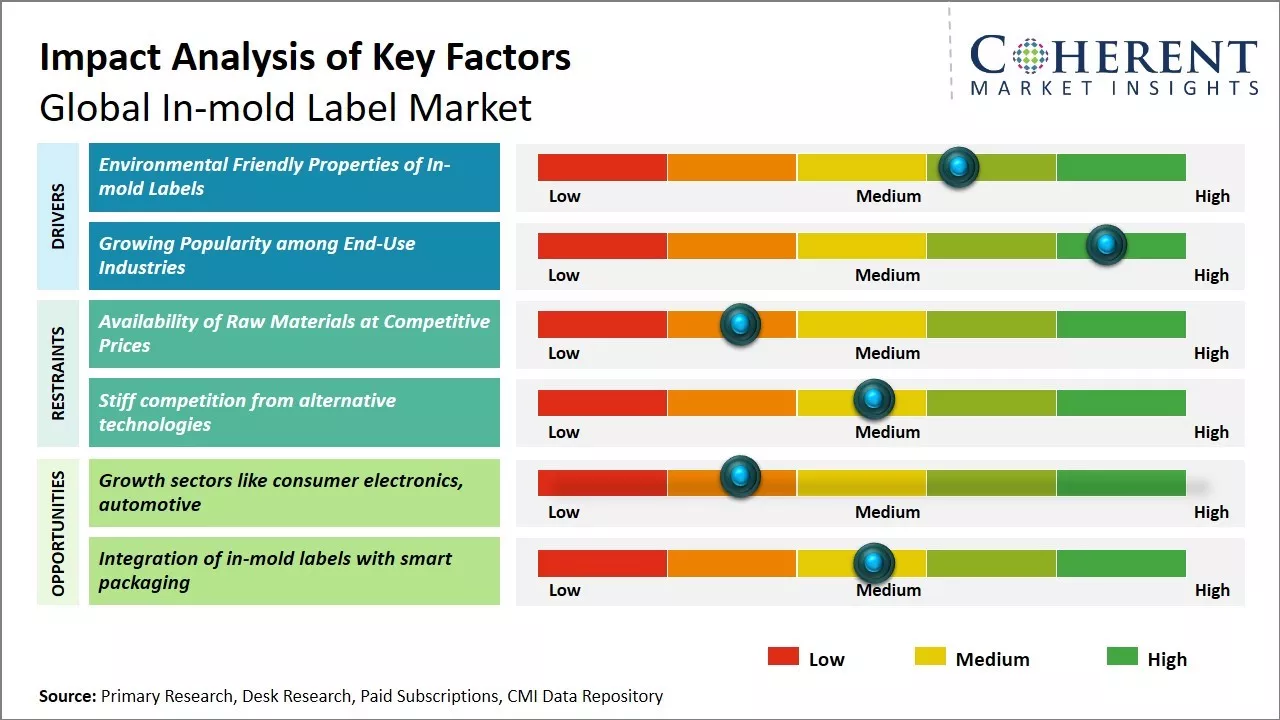
Discover market dynamics shaping the industry: Download Free Sample
The global in-mold label market is expected to witness significant growth during the forecast period. This growth can be attributed to the increasing demand for short run label jobs across industries such as food and beverage, pharmaceuticals, personal care, and automotive. In-mold labeling offers superior product aesthetics, scratch resistance, and excellent durable labeling solution, thus finding increasing preference across various end-use industries. Rising demand for eco-friendly labels along with appeal for cost-effective labeling technology is further expected to propel the demand for in-mold labels. Shift towards sustainable and efficient labeling solutions and expansion of the e-commerce sector particularly in emerging economies are likely to pave opportunities for in-mold label market in upcoming years.
Environmental Friendly Properties of In-mold Labels
One of the major drivers propelling the growth of the global in-mold label market is the environment friendly properties of these labels. In-mold labels provide manufacturers an eco-friendly alternative to traditional pressure sensitive labels without compromising on functionality. As environment sustainability has become a key focus area across industries, companies are under increasing pressure from consumers as well as regulatory bodies to reduce waste and adopt greener production techniques. In-mold labels help address this need as they are lighter in weight and require less raw material to produce compared to pressure sensitive labels. Additionally, since they are not separate pieces added to packaging later but instead molded directly onto the product during manufacturing, there is no left over release liner film that needs to be disposed of. This results in less packaging scrap at the production line. What's more, in-mold labels increase production efficiency by eliminating extra steps involved in applying separate labels to products and packages. Many branded goods and consumer product companies have switched to in-mold labels for their primary, secondary, or tamper evident labeling needs to lower operational costs as well as shrink the environmental footprint of their packaging line.
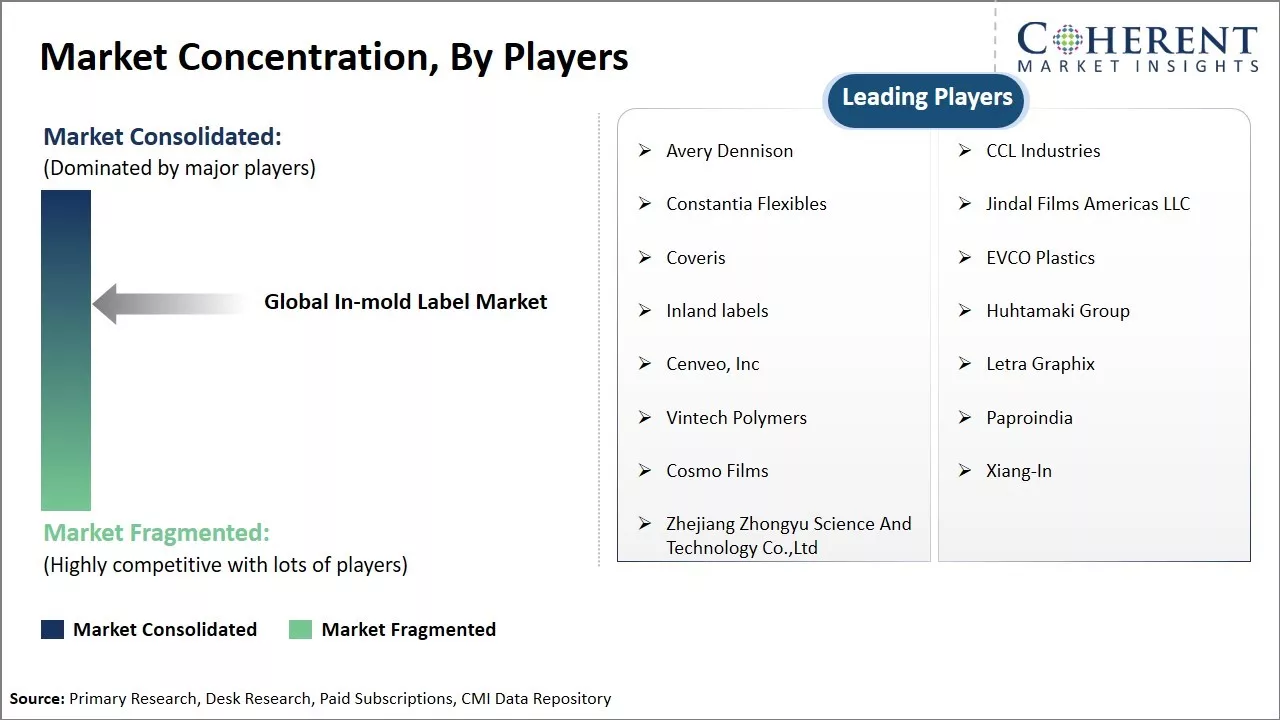
Get actionable strategies to beat competition: Download Free Sample
Growing Popularity among End-use Industries
Another major factor driving the adoption of the in-mold labeling solution is its growing popularity among various end-use industries for both promotional and functional labeling applications. Industries such as food and beverages, automotive, personal care, and cosmetics amongst others have increased their spending on in-mold labels significantly over the recent past years. This is because these labels provide excellent protection from abrasion, moisture, chemicals, and other production line hazards for products while also allowing aesthetically appealing designs and customized branding and marketing messages to be seamlessly integrated into the package or part. Several FMCG companies are investing in new in-mold labeling machines as they want durable labels that can pass through high-speed production and distribution with products clearly branded and tagged. Automotive OEMs and component makers also prefer using these labels for vehicle part identification and traceability, especially for exteriors and interiors. Even industries like healthcare and electronics which had traditionally used stick-on labels more are now deploying in-mold ones for product safety labeling, tracking, and authentication purposes owing to their resilience. This diversifying popularity across sectors continues to open new opportunities and drive higher demand. Growing end-use industries are expected to drive the market growth. According to data published by IBEF in 2023, the Indian cosmetics industry is majorly categorized into the skin care, hair care, oral care, fragrances, and color cosmetics segments. The overall market share is expected to grow to US$ 20 billion by 2025 with a Compound Annual Growth Rate (CAGR) of 25%.
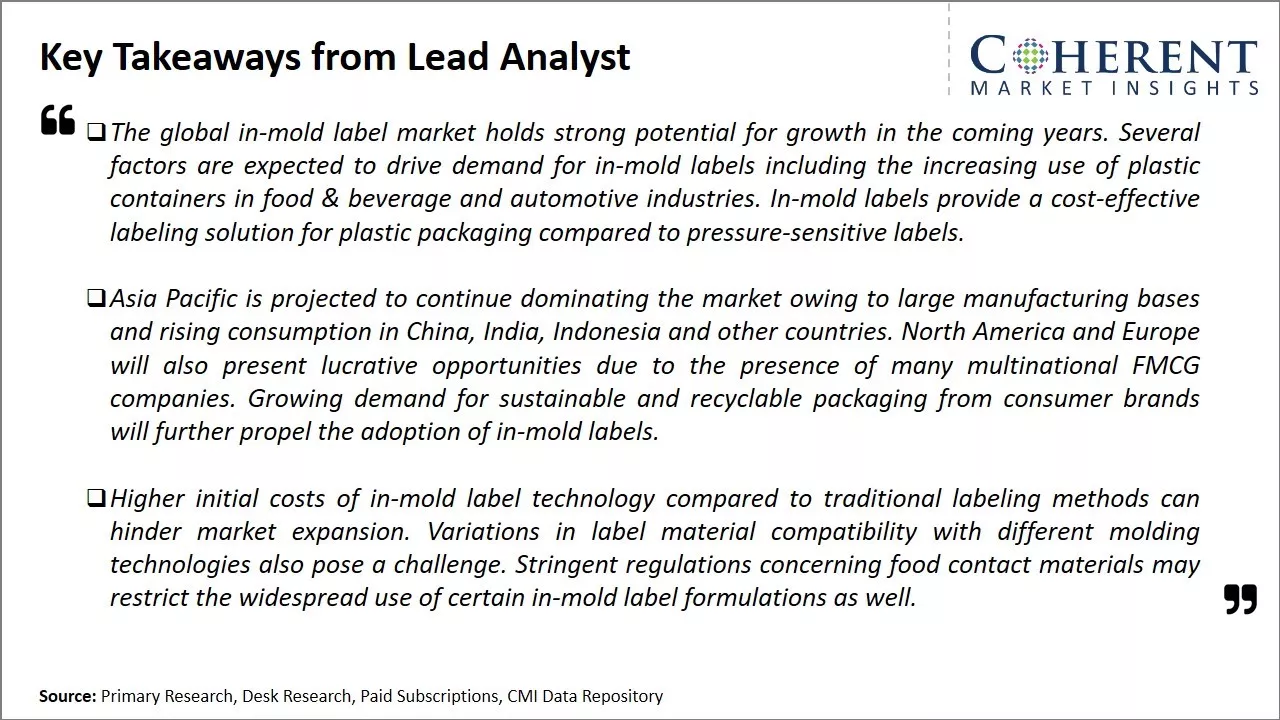
To learn more about this report, Download Free Sample
Market Challenges: Availability of raw materials at competitive pricesOne of the key challenges for the global in-mold label market is the availability of raw materials at competitive prices. As in-mold labels are primarily made from polypropylene and polyethylene, fluctuating prices of these commodities impact the production costs for manufacturers. Additionally, short product life cycles in many end-use industries like consumer electronics pose difficulties in terms of optimizing inventory levels and forecasting demand fluctuations. Developing labels that can withstand higher temperatures during processing is another major challenge, as it expands the scope of applicability.
Market Opportunities: Growth sectors like consumer electronics, automotive
The global in-mold label market is expected to witness significant growth over the coming years driven by opportunities in industries like consumer electronics, automotive, food and beverages. Adoption is increasing especially in developing regions of Asia Pacific and Central and Latin America.
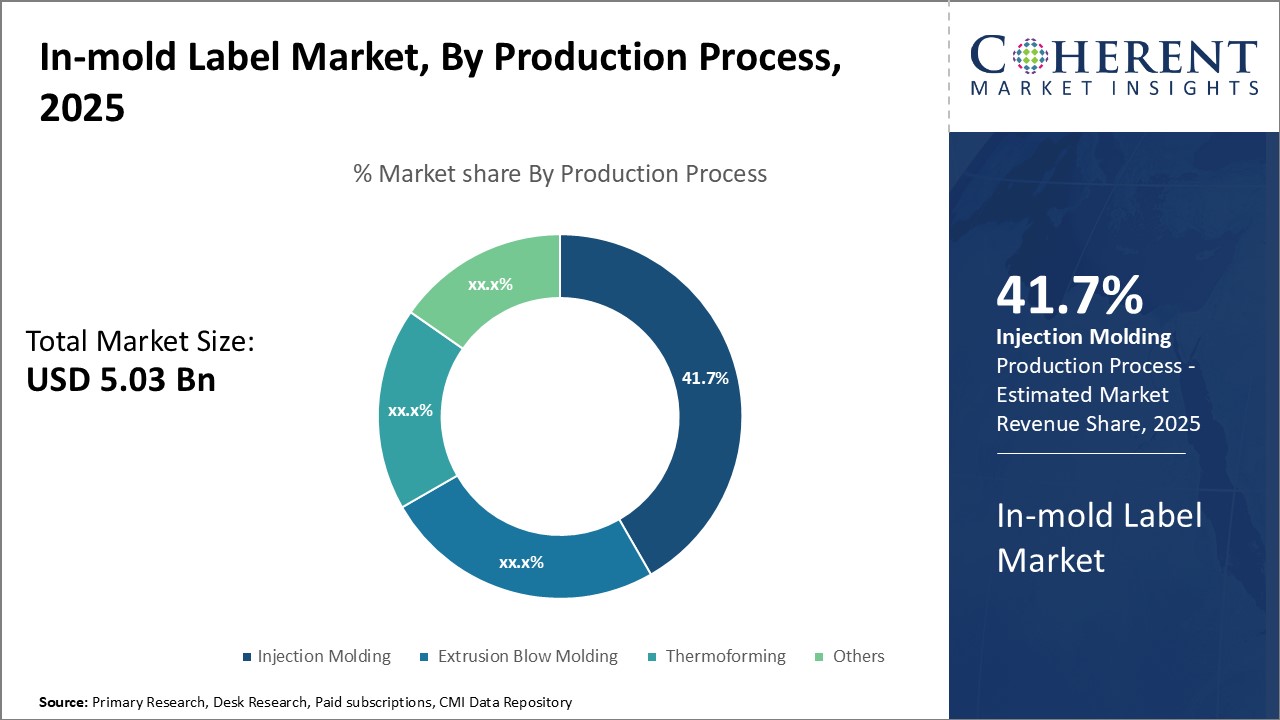
Discover high revenue pocket segments and roadmap to it: Download Free Sample
Insights, By Production Process: Optimized Cost and Efficiency: Reasons for Injection Molding's Dominance
In terms of production process, injection molding contributes 41.7% share of the market owing to its ability to provide optimized cost and manufacturing efficiency. Injection molding allows for high-speed, high-volume production of in-mold labels in a cost-effective manner. It has lower tooling and start-up costs compared to other processes like blow molding. Additionally, injection molding delivers precise dimensional consistency and repeatability ideal for labeling applications. The process enables embedding labels directly into products during molding, eliminating the need for gluing or adhesive application later. This integrated process streamlines production and reduces manual labor involvement. Injection molding also offers versatility to produce labels in varying shapes, sizes and materials as per application needs. Its optimized production speeds and costs provide compelling returns for manufacturers.
Insights, By Material: Superior Material Properties: Factors Contributing to Polypropylene's Dominance
In terms of material, polypropylene contributes 36.1% share of the market owing to its superior material properties ideal for in-mold labeling. Polypropylene is a light, durable, and chemically resistant material suitable for product packaging and labeling. It maintains its strength, flexibility, and clarity properties over a wide temperature range. This temperature resistance allows polypropylene labels to withstand high molding temperatures without distorting. It also offers scratch, moisture, and solvent resistance protecting labels during product manufacture, storage, transportation, and usage. Polypropylene's non-polar nature makes it compatible for embedding into a variety of container substrates using injection molding. Its stiffness, clarity and ability to be embossed or printed upon also meets aesthetic and branding requirements on containers. Combined with its competitive pricing, these attributes have made polypropylene the material of choice for the in-mold label market.
Insights, By Printing Technology: Outstanding Barrier Properties Drive Plastic's Dominance
In terms of printing technology, UV curable inks contribute 41.9% share of the market owing to their advanced printing versatility. UV curable inks shorten a label's printing-to-curing process timeline. They instantly cure under UV light exposure, eliminating the need for additional drying or curing stages. This accelerated drying allows higher print speeds and job throughput. UV inks are solvent-free and emit lower volatile organic compounds, helping reduce environmental footprint. They provide durable, scratch resistant prints surviving product handling and distribution. UV inks also deliver vibrant colors and resolution, meeting standards for package decoration and branding. Importantly, they are suited for several label substrates like polypropylene. Their adhesion properties ensure print integrity even during rigid molding processes. Collectively, these advantageous printing attributes have made UV curing the technology of choice for on-demand, short-run production favored in the customization-focused in-mold label market.
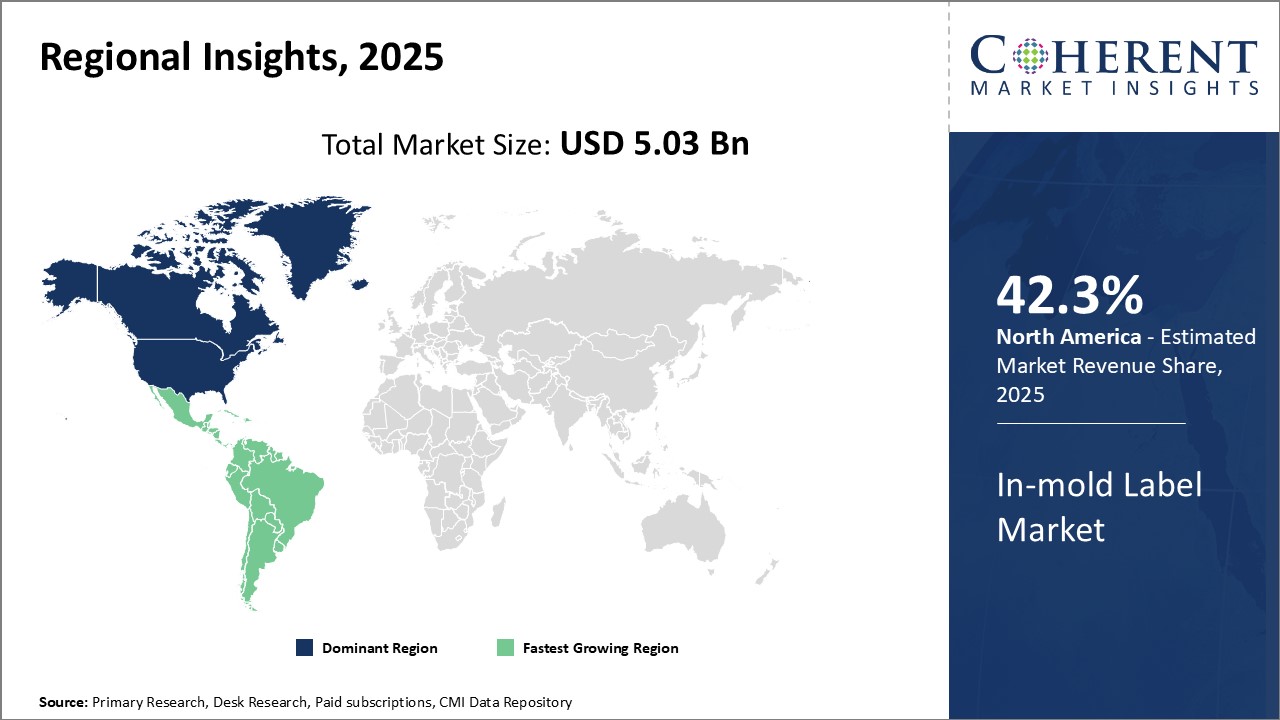
Need a Different Region or Segment? Download Free Sample
North America has established itself as the dominant region in the global in-mold label market with 42.3% of the market share. With a strong presence of packaging companies and label converters, the U.S. and Canada accounted for the major share. The automotive industry in the region is one of the largest across the world which drives the demand for in-mold labels from OEMs. Stringent regulations around product labeling and information have further boosted adoption. Key players like Avery Dennison, CCL Industries, and Multi-Color Corporation being headquartered in the region prove the mature supply chain capabilities. Their investments in R&D have led to continuous innovation and high quality products. Export growth to Latin America and Europe have also strengthened the regional market position. However, price wars owing to overcapacity can threaten the margins of suppliers.
The Asia Pacific region is witnessing the fastest rise and emerging as the new hotspot. While China continues to reign as the manufacturing hub, other developing nations like India and Indonesia are picking up pace rapidly. This is backed by growing consumption, favorable policies attracting investments as well as low labor costs. The rising middle class is increasing the usage of packaged goods ranging from food & beverages to cosmetics. Local players are making strong efforts to boost production volumes. However, the need for advanced machinery and technical expertise remains. Partnerships with multinational corporations can help enhance local capabilities and infrastructure to tap the immense untapped potential.
In-mold Label Market Report Coverage
| Report Coverage | Details | ||
|---|---|---|---|
| Base Year: | 2024 | Market Size in 2025: | USD 5.03 Bn |
| Historical Data for: | 2020 To 2024 | Forecast Period: | 2025 To 2032 |
| Forecast Period 2025 to 2032 CAGR: | 6.3% | 2032 Value Projection: | USD 7.72 Bn |
| Geographies covered: |
|
||
| Segments covered: |
|
||
| Companies covered: |
Avery Dennison, CCL Industries, Constantia Flexibles, Jindal Films Americas LLC, Coveris, EVCO Plastics, Inland labels, Huhtamaki Group , Cenveo, Inc, Letra Graphix, Vintech Polymers, Paproindia, Cosmo Films, Xiang-In, and Zhejiang Zhongyu Science And Technology Co.,Ltd |
||
| Growth Drivers: |
|
||
| Restraints & Challenges: |
|
||
Uncover macros and micros vetted on 75+ parameters: Get instant access to report
Share
Share
About Author
Vidyesh Swar is a seasoned Consultant with a diverse background in market research and business consulting. With over 6 years of experience, Vidyesh has established a strong reputation for his proficiency in market estimations, supplier landscape analysis, and market share assessments for tailored research solution. Using his deep industry knowledge and analytical skills, he provides valuable insights and strategic recommendations, enabling clients to make informed decisions and navigate complex business landscapes.
Missing comfort of reading report in your local language? Find your preferred language :
Transform your Strategy with Exclusive Trending Reports :
Frequently Asked Questions
Joining thousands of companies around the world committed to making the Excellent Business Solutions.
View All Our Clients